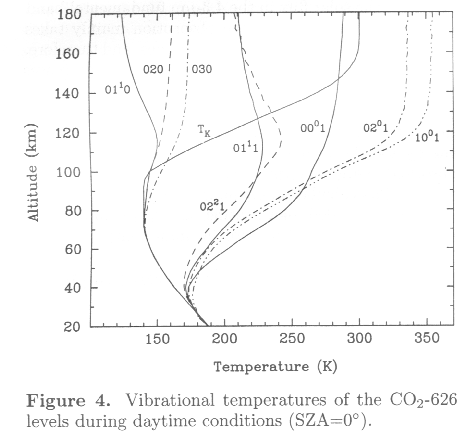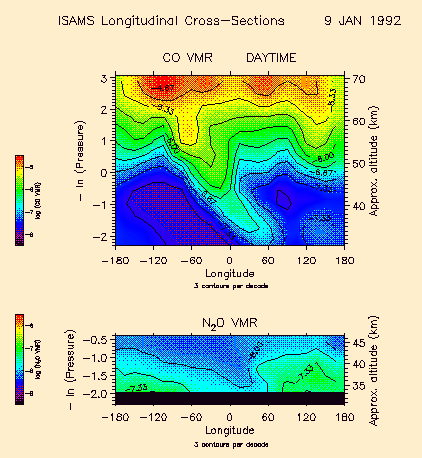- NON-LTE MODELLING OF IR EMISSIONS IN MARS' ATMOSPHERE
Development of a highly complete non-LTE model for understanding the
CO2 atmospheric emissions in Mars and their impacts on the energy balance
of that atmosphere. This model was specially designed to study potential
non-LTE effects in the remote sounding of the temperature in the martian
upper atmosphere by the instrument PMIRR, on board the malograted Mars Observer. Since PMIRR
will be one of the instruments in the orbiter of the future Mars Surveyor,
we will still be able to evaluate those effects and validate our model.
This model also represents one of
the best candidates to build reference parameterizations of non-LTE
solar heating rates and thermal cooling rates for operative
Global Circulation Models (GCM) of the martian atmosphere, like those
developed at the Mars GCM
Group of NASA-Ames Research
Center, or at the Planetary
Group of the Dept. of
Physics, Oxford University.
The complexity of these NLTE models is double. First, a set of
statistical equilibrium equations for every excited level has to be set
up, including all the microscopic processes afecting the levels, in
particular a complex scheme of
collisional processes among all the levels, and secondly, in a CO2
atmosphere the radiative exchange between layers is important in many CO2 transitions, and the
radiative transfer equation for many bands must be solved accurately,
simultaneously with the statistical equilibrium equations for every level
considered.
The following figure is taken from Lopez-Valverde and Lopez-Puertas,
J. Geophys. Res. 99, 13117-13132, 1994.

- RETRIEVAL OF MIDDLE ATMOSPHERE CO IN POLAR REGIONS
Retrieval of CO abundance in the stratosphere and mesosphere from the
non-LTE radiances measured by the Improved Stratospheric and Mesospheric
Sounder (ISAMS) on
UARS
. This is the first time that retrievals from
IR emissions presenting variability from LTE to non-LTE regions are
performed operationally to obtain full profile abundances. The results
represent the first global measurements of this important dynamics tracer
in the mesosphere and in polar regions.
The following figure is a coloured version of Figure 11 in
Lopez-Valverde et al., J. Geophys. Res. 101, 9929-9955, 1996.

- RADIATIVE PROPERTIES OF CO2 ATMOSPHERES
Planetary intercomparison (Mars-Venus) of the radiative
properties and non-LTE effects on the upper layers' dynamics of a CO2
atmosphere. Radiative equilibrium temperatures have been obtained for the
atmosphere of Mars, as shown in the following figure, taken from
Lopez-Puertas and Lopez-Valverde, ICARUS, 114 113-129, 1995.

We are starting to obtain results on radiative relaxation
times and radiative equilibrum temperatures in the atmosphere of Venus
with the help of a non-LTE model currently under development for that
atmosphere. Results will be compared with those of the martian
atmosphere and will be available here very soon.
- CO2 abundances in the upper atmosphere
We have derived information on the abundance of CO2 in the upper
mesosphere and lower thermosphere from ISAMS measurements at 4.6
um (the wideband signal). The results have been published by
Lopez-Puertas et al., JGR, 103, pp.8515-8530, 1998. A summary
can be found here.






 Back to
Back to
